The Road to Developing Economically Feasible Plans for Green, Comfortable and Energy Efficient Buildings
Abstract
1. Introduction
- The optimization problems are classified to SOO and MOO, and they are compared to each other. In addition, the studies that evaluated both SOO and MOO are also taken into account.
- All the key parameters in an optimization problem are considered and the investigations are analyzed based on each of them, separately. The key parameters include objective functions, decision variables, and constraints. There have been nine different aspects from which objective functions have been selected so far. The review investigates all the nine aspects completely and in detail.
- The studies are also categorized and investigated based on other criteria, such as optimization algorithms and software programs. Moreover, software programs are divided into building simulation-based and optimization tools.
- The review is written in a way that it provides information for not only architects but also other experts in the building sector.
2. Paper Searching Methodology
3. Overview of the Studies Selected
3.1. Single-Objective Optimization (SOO)
3.2. Multi-Objective Optimization (MOO)
3.3. Single-Objective Versus Multi-Objective Optimization
4. Overview of the Selected Studies
4.1. Objective Functions
- Energy consumption (E.C);
- Thermal comfort (T.C);
- Economic benefit (E.B);
- Visual comfort (V.C);
- Environmental impact (E.I);
- Shape (S.);
- Artwork preservation risk (A.P.R);
- Aesthetical perception (A.P);
- Water consumption (W.C).
4.1.1. Energy Consumption
4.1.2. Thermal Comfort
4.1.3. Economic Benefit
4.1.4. Visual Comfort
4.1.5. Environmental Impact
4.1.6. Others
- Shape;
- Artwork preservation risk;
- Aesthetic perception;
- Water consumption.
4.1.7. Summary Report
- E.B has been enhanced in the range of 4.6–39.56% [54] with an average of 24.0%.
- V.C has been increased in the range of 15.0–63.0% [45] with an average of 35.0%.
- The three indicators of the shape aspect, including solar radiation gain, shape coefficient, and space efficiency have been enhanced by 30–53%, 15–20%, and less than 10% [40], respectively.
4.2. Decision Variables
4.3. Constraints
4.4. The Considered Case Studies
4.5. Optimization Algorithm and Simulation Software
- Using artificial intelligence tools to provide predictions from changes in occupants’ behavior and climate change in the future years of building life.
- Adding more powerful economic databases for better evaluation of the building from this point of view.
- Providing “tagging” possibility for each project done by an individual in a way that if wanted, could enable the tags to be shared on an online database with other people. In this way, researchers will have better interactions together.
- Applying the virtual reality to get the chance of understanding the graphical issues related to works in a much more perfect way.
5. Conclusions
- How could the policy makers help to put the results of BPO into practice for a town, a city, or a country?
- How could changing the occupants’ behavior could affect the optimum values of decision variables and objective functions?
- Could some dimensionless numbers be defined as the decision variables and objective functions to reach a general BPO method and provide the possibility of better comparisons for various buildings?
- Would it be possible to find an updated procedure for BPO in which different buildings are optimized altogether? How much further improvement will be achieved under that condition?
- Could the current BPO procedure be modified to provide plans for adding renewable energy resources?
- How many changes will be made to the results of BPO by the future changes in the climate, buildings design techniques, and the employed masonry materials?
- Conducting multi-objective optimization in which more aspects from different sides are taken into account;
- Performing multi-objective optimization by considering the objective functions based on the application and the climatic zone;
- Combining the efficient software programs and algorithms to have more effective and faster calculations;
- Selecting the case studies in which the multi-objective optimization has been done less often, and taking the advantage of BPO for them;
- Identifying the aspects which have not been usually optimized in each application and considering them;
- Studying the impacts of different strategies for giving incentives to implement the results of BPO;
- Taking advantage of new optimization techniques like dynamic multi-objective optimization to provide a better outcome.
Funding
Conflicts of Interest
Abbreviations
| SOO | single-objective optimization |
| MOO | multi-objective optimization |
| BPO | building performance optimization |
| E.C | energy consumption |
| T.C | thermal comfort |
| E.B | economic benefit |
| V.C | visual comfort |
| E.I | environmental impact |
| S. | shape |
| A.P.R | artwork preservation risk |
| A.P | aesthetical perception |
| W.C | water consumption |
| NSGA-II | non-dominated sorting genetic algorithm II |
References
- Manfren, M.; Nastasi, B.; Tronchin, L. Linking design and operation phase energy performance analysis through regression-based approaches. Front. Energy Res. 2020, 8, 557649. [Google Scholar] [CrossRef]
- Mancini, F.; Nardecchia, F.; Groppi, D.; Ruperto, F.; Romeo, C. Indoor Environmental Quality Analysis for Optimizing Energy Consumptions Varying Air Ventilation Rates. Sustainability 2020, 12, 482. [Google Scholar] [CrossRef]
- Hoseinzadeh, S.; Hadi Zakeri, M.; Shirkhani, A.; Chamkha, A.J. Analysis of energy consumption improvements of a zero-energy building in a humid mountainous area. J. Renew. Sustain. Energy 2019, 11, 015103. [Google Scholar] [CrossRef]
- Safari, M.; Sohani, A.; Sayyaadi, H. A higher performance optimum design for a tri-generation system by taking the advantage of water-energy nexus. J. Clean. Prod. 2021, 284, 124704. [Google Scholar] [CrossRef]
- Adhikari, R.S.; Aste, N.; Manfren, M. Optimization concepts in district energy design and management–A case study. Energy Procedia 2012, 14, 1386–1391. [Google Scholar] [CrossRef]
- Astiaso Garcia, D.; Cumo, F.; Tiberi, M.; Sforzini, V.; Piras, G. Cost-benefit analysis for energy management in public buildings: Four Italian case studies. Energies 2016, 9, 522. [Google Scholar] [CrossRef]
- Dagdougui, Y.; Ouammi, A.; Benchrifa, R. High Level Controller based Energy Management for a Smart Building Integrated Microgrid with Electric Vehicle. Front. Energy Res. 2020, 8, 248. [Google Scholar] [CrossRef]
- Sohani, A.; Sayyaadi, H. Employing genetic programming to find the best correlation to predict temperature of solar photovoltaic panels. Energy Convers. Manag. 2020, 224, 113291. [Google Scholar] [CrossRef]
- Tronchin, L.; Manfren, M.; Tagliabue, L.C. Optimization of building energy performance by means of multi-scale analysis–Lessons learned from case studies. Sustain. Cities Soc. 2016, 27, 296–306. [Google Scholar] [CrossRef]
- Elnagar, E.; Köhler, B. Reduction of the energy demand with passive approaches in multifamily nearly Zero-Energy Buildings under different climate conditions. Front. Energy Res. 2020, 8, 224. [Google Scholar] [CrossRef]
- Sarafraz, M.M.; Dareh Baghi, A.; Safaei, M.R.; Leon, A.S.; Ghomashchi, R.; Goodarzi, M.; Lin, C.-X. Assessment of Iron Oxide (III)–Therminol 66 Nanofluid as a Novel Working Fluid in a Convective Radiator Heating System for Buildings. Energies 2019, 12, 4327. [Google Scholar] [CrossRef]
- Fajilla, G.; De Simone, M.; Cabeza, L.F.; Bragança, L. Assessment of the Impact of Occupants’ Behavior and Climate Change on Heating and Cooling Energy Needs of Buildings. Energies 2020, 13, 6468. [Google Scholar] [CrossRef]
- Grygierek, K.; Sarna, I. Impact of Passive Cooling on Thermal Comfort in a Single-Family Building for Current and Future Climate Conditions. Energies 2020, 13, 5332. [Google Scholar] [CrossRef]
- Pacak, A.; Worek, W. Review of Dew Point Evaporative Cooling Technology for Air Conditioning Applications. Appl. Sci. 2021, 11, 934. [Google Scholar] [CrossRef]
- Sayegh, M.A.; Ludwińska, A.; Rajski, K.; Dudkiewicz, E. Environmental and energy saving potential from greywater in hotels. Sci. Total Environ. 2021, 761, 143220. [Google Scholar] [CrossRef]
- Golizadeh Akhlaghi, Y.; Aslansefat, K.; Zhao, X.; Sadati, S.; Badiei, A.; Xiao, X.; Shittu, S.; Fan, Y.; Ma, X. Hourly performance forecast of a dew point cooler using explainable Artificial Intelligence and evolutionary optimisations by 2050. Appl. Energy 2021, 281, 116062. [Google Scholar] [CrossRef]
- Settino, J.; Carpino, C.; Perrella, S.; Arcuri, N. Multi-Objective Analysis of a Fixed Solar Shading System in Different Climatic Areas. Energies 2020, 13, 3249. [Google Scholar] [CrossRef]
- Wong, J.K.W.; Zhou, J. Enhancing environmental sustainability over building life cycles through green BIM: A review. Autom. Constr. 2015, 57, 156–165. [Google Scholar] [CrossRef]
- Carlucci, S.; Causone, F.; De Rosa, F.; Pagliano, L. A review of indices for assessing visual comfort with a view to their use in optimization processes to support building integrated design. Renew. Sustain. Energy Rev. 2015, 47, 1016–1033. [Google Scholar] [CrossRef]
- Shi, X.; Tian, Z.; Chen, W.; Si, B.; Jin, X. A review on building energy efficient design optimization rom the perspective of architects. Renew. Sustain. Energy Rev. 2016, 65, 872–884. [Google Scholar] [CrossRef]
- Bonyadi, M.R.; Michalewicz, Z. Particle Swarm Optimization for Single Objective Continuous Space Problems: A Review; MIT Press: Cambridge, MA, USA, 2017. [Google Scholar]
- Kumar, A.; Sah, B.; Singh, A.R.; Deng, Y.; He, X.; Kumar, P.; Bansal, R. A review of multi criteria decision making (MCDM) towards sustainable renewable energy development. Renew. Sustain. Energy Rev. 2017, 69, 596–609. [Google Scholar] [CrossRef]
- Tian, Z.; Zhang, X.; Jin, X.; Zhou, X.; Si, B.; Shi, X. Towards adoption of building energy simulation and optimization for passive building design: A survey and a review. Energy Build. 2018, 158, 1306–1316. [Google Scholar] [CrossRef]
- Ekici, B.; Cubukcuoglu, C.; Turrin, M.; Sariyildiz, I.S. Performative computational architecture using swarm and evolutionary optimisation: A review. Build. Environ. 2019, 147, 356–371. [Google Scholar] [CrossRef]
- Alothaimeen, I.; Arditi, D. Overview of multi-objective optimization approaches in construction project management. In Multi-criteria Optimization-Pareto-Optimal and Related Principles; IntechOpen: London, UK, 2019. [Google Scholar]
- Joench, R.L.; Soares, J.; Lezama, F.; Ramos, S.; Gomes, A.; Vale, Z. A Short Review on Smart Building Energy Resource Optimization. In Proceedings of the 2019 IEEE PES GTD Grand International Conference and Exposition Asia (GTD Asia), Bangkok, Thailand, 19–23 March 2019; pp. 440–445. [Google Scholar]
- Abdallah, M.; El-Rayes, K. Optimizing the selection of building upgrade measures to minimize the operational negative environmental impacts of existing buildings. Build. Environ. 2015, 84, 32–43. [Google Scholar] [CrossRef]
- Mangkuto, R.A.; Rohmah, M.; Asri, A.D. Design optimisation for window size, orientation, and wall reflectance with regard to various daylight metrics and lighting energy demand: A case study of buildings in the tropics. Appl. Energy 2016, 164, 211–219. [Google Scholar] [CrossRef]
- Ferdyn-Grygierek, J.; Grygierek, K. Multi-variable optimization of building thermal design using genetic algorithms. Energies 2017, 10, 1570. [Google Scholar] [CrossRef]
- Baglivo, C.; Congedo, P.; Di Cataldo, M.; Coluccia, L.; D’Agostino, D. Envelope design optimization by thermal modelling of a building in a warm climate. Energies 2017, 10, 1808. [Google Scholar] [CrossRef]
- Bamdad, K.; Cholette, M.E.; Guan, L.; Bell, J. Ant colony algorithm for building energy optimisation problems and comparison with benchmark algorithms. Energy Build. 2017, 154, 404–414. [Google Scholar] [CrossRef]
- Zhou, Z.; Wang, C.; Sun, X.; Gao, F.; Feng, W.; Zillante, G. Heating energy saving potential from building envelope design and operation optimization in residential buildings: A case study in northern China. J. Clean. Prod. 2018, 174, 413–423. [Google Scholar] [CrossRef]
- Li, Z.; Chen, H.; Lin, B.; Zhu, Y. Fast bidirectional building performance optimization at the early design stage. Build. Simul. 2018, 11, 647–661. [Google Scholar] [CrossRef]
- Sghiouri, H.; Mezrhab, A.; Karkri, M.; Naji, H. Shading devices optimization to enhance thermal comfort and energy performance of a residential building in Morocco. J. Build. Eng. 2018, 18, 292–302. [Google Scholar] [CrossRef]
- Xue, P.; Li, Q.; Xie, J.; Zhao, M.; Liu, J. Optimization of window-to-wall ratio with sunshades in China low latitude region considering daylighting and energy saving requirements. Appl. Energy 2019, 233, 62–70. [Google Scholar] [CrossRef]
- Echenagucia, T.M.; Capozzoli, A.; Cascone, Y.; Sassone, M. The early design stage of a building envelope: Multi-objective search through heating, cooling and lighting energy performance analysis. Appl. Energy 2015, 154, 577–591. [Google Scholar] [CrossRef]
- Yu, W.; Li, B.; Jia, H.; Zhang, M.; Wang, D. Application of multi-objective genetic algorithm to optimize energy efficiency and thermal comfort in building design. Energy Build. 2015, 88, 135–143. [Google Scholar] [CrossRef]
- Carlucci, S.; Cattarin, G.; Causone, F.; Pagliano, L. Multi-objective optimization of a nearly zero-energy building based on thermal and visual discomfort minimization using a non-dominated sorting genetic algorithm (NSGA-II). Energy Build. 2015, 104, 378–394. [Google Scholar] [CrossRef]
- Ascione, F.; Bianco, N.; De Masi, R.; Mauro, G.; Vanoli, G. Design of the building envelope: A novel multi-objective approach for the optimization of energy performance and thermal comfort. Sustainability 2015, 7, 10809–10836. [Google Scholar] [CrossRef]
- Zhang, L.; Zhang, L.; Wang, Y. Shape optimization of free-form buildings based on solar radiation gain and space efficiency using a multi-objective genetic algorithm in the severe cold zones of China. Sol. Energy 2016, 132, 38–50. [Google Scholar] [CrossRef]
- Gadelhak, M.; Lang, W. Optimization of office building facade to enhance daylighting, thermal comfort and energy use intensity. In Proceedings of the Third IBPSA—England Conference, Newcastle Upon Tyne, UK, 12–14 September 2016; pp. 12–14. [Google Scholar]
- Pan, L.; Li, K.; Xue, W.; Liu, G. Multi-objective optimization for building performance design considering thermal comfort and energy consumption. In Proceedings of the 2016 35th Chinese Control Conference (CCC), Chengdu, China, 27–29 July 2016; pp. 2799–2803. [Google Scholar]
- Ascione, F.; Bianco, N.; De Stasio, C.; Mauro, G.M.; Vanoli, G.P. CASA, cost-optimal analysis by multi-objective optimisation and artificial neural networks: A new framework for the robust assessment of cost-optimal energy retrofit, feasible for any building. Energy Build. 2017, 146, 200–219. [Google Scholar] [CrossRef]
- Bingham, R.; Agelin-Chaab, M.; Rosen, M.A. Multi-objective optimization of a residential building envelope in the bahamas. In Proceedings of the 2017 IEEE International Conference on Smart Energy Grid Engineering (SEGE), Oshawa, ON, Canada, 14–17 August 2017; pp. 294–301. [Google Scholar]
- Zhang, A.; Bokel, R.; van den Dobbelsteen, A.; Sun, Y.; Huang, Q.; Zhang, Q. Optimization of thermal and daylight performance of school buildings based on a multi-objective genetic algorithm in the cold climate of China. Energy Build. 2017, 139, 371–384. [Google Scholar] [CrossRef]
- Mostavi, E.; Asadi, S.; Boussaa, D. Development of a new methodology to optimize building life cycle cost, environmental impacts, and occupant satisfaction. Energy 2017, 121, 606–615. [Google Scholar] [CrossRef]
- Bre, F.; Fachinotti, V.D. A computational multi-objective optimization method to improve energy efficiency and thermal comfort in dwellings. Energy Build. 2017, 154, 283–294. [Google Scholar] [CrossRef]
- Hamdy, M.; Mauro, G. Multi-Objective Optimization of Building Energy Design to Reconcile Collective and Private Perspectives: CO2-eq vs. Discounted Payback Time. Energies 2017, 10, 1016. [Google Scholar] [CrossRef]
- Wu, W.; Guo, J.; Li, J.; Hou, H.; Meng, Q.; Wang, W. A multi-objective optimization design method in zero energy building study: A case study concerning small mass buildings in cold district of China. Energy Build. 2018, 158, 1613–1624. [Google Scholar] [CrossRef]
- Lin, Y.; Zhou, S.; Yang, W.; Li, C.-Q. Design optimization considering variable thermal mass, insulation, absorptance of solar radiation, and glazing ratio using a prediction model and genetic algorithm. Sustainability 2018, 10, 336. [Google Scholar] [CrossRef]
- Grygierek, K.; Ferdyn-Grygierek, J. Multi-objective optimization of the envelope of building with natural ventilation. Energies 2018, 11, 1383. [Google Scholar] [CrossRef]
- Schito, E.; Conti, P.; Testi, D. Multi-objective optimization of microclimate in museums for concurrent reduction of energy needs, visitors’ discomfort and artwork preservation risks. Appl. Energy 2018, 224, 147–159. [Google Scholar] [CrossRef]
- Gou, S.; Nik, V.M.; Scartezzini, J.-L.; Zhao, Q.; Li, Z. Passive design optimization of newly-built residential buildings in Shanghai for improving indoor thermal comfort while reducing building energy demand. Energy Build. 2018, 169, 484–506. [Google Scholar] [CrossRef]
- Harkouss, F.; Fardoun, F.; Biwole, P.H. Multi-objective optimization methodology for net zero energy buildings. J. Build. Eng. 2018, 16, 57–71. [Google Scholar] [CrossRef]
- Sohani, A.; Sayyaadi, H.; Zeraatpisheh, M. Optimization strategy by a general approach to enhance improving potential of dew-point evaporative coolers. Energy Convers. Manag. 2019, 188, 177–213. [Google Scholar] [CrossRef]
- Zemero, B.R.; Tostes, M.E.d.L.; Bezerra, U.H.; Batista, V.d.S.; Carvalho, C.C.M. Methodology for Preliminary Design of Buildings Using Multi-Objective Optimization Based on Performance Simulation. J. Sol. Energy Eng. 2019, 141, 040801. [Google Scholar] [CrossRef]
- Yi, Y.K. Building facade multi-objective optimization for daylight and aesthetical perception. Build. Environ. 2019, 156, 178–190. [Google Scholar] [CrossRef]
- Hong, T.; Kim, J.; Lee, M. A multi-objective optimization model for determining the building design and occupant behaviors based on energy, economic, and environmental performance. Energy 2019, 174, 823–834. [Google Scholar] [CrossRef]
- Kirimtat, A.; Krejcar, O.; Ekici, B.; Tasgetiren, M.F. Multi-objective energy and daylight optimization of amorphous shading devices in buildings. Sol. Energy 2019, 185, 100–111. [Google Scholar] [CrossRef]
- Ascione, F.; Bianco, N.; Mauro, G.M.; Napolitano, D.F. Building envelope design: Multi-objective optimization to minimize energy consumption, global cost and thermal discomfort. Application to different Italian climatic zones. Energy 2019, 174, 359–374. [Google Scholar] [CrossRef]
- Zhai, Y.; Wang, Y.; Huang, Y.; Meng, X. A multi-objective optimization methodology for window design considering energy consumption, thermal environment and visual performance. Renew. Energy 2019, 134, 1190–1199. [Google Scholar] [CrossRef]
- Si, B.; Wang, J.; Yao, X.; Shi, X.; Jin, X.; Zhou, X. Multi-objective optimization design of a complex building based on an artificial neural network and performance evaluation of algorithms. Adv. Eng. Inform. 2019, 40, 93–109. [Google Scholar] [CrossRef]
- Sharif, S.A.; Hammad, A. Simulation-based multi-objective optimization of institutional building renovation considering energy consumption, life-cycle cost and life-cycle assessment. J. Build. Eng. 2019, 21, 429–445. [Google Scholar] [CrossRef]
- Fang, Y.; Cho, S. Design optimization of building geometry and fenestration for daylighting and energy performance. Sol. Energy 2019, 191, 7–18. [Google Scholar] [CrossRef]
- Sohani, A.; Sayyaadi, H.; Azimi, M. Employing static and dynamic optimization approaches on a desiccant-enhanced indirect evaporative cooling system. Energy Convers. Manag. 2019, 199, 112017. [Google Scholar] [CrossRef]
- Lu, Y.; Wang, S.; Zhao, Y.; Yan, C. Renewable energy system optimization of low/zero energy buildings using single-objective and multi-objective optimization methods. Energy Build. 2015, 89, 61–75. [Google Scholar] [CrossRef]
- Delgarm, N.; Sajadi, B.; Kowsary, F.; Delgarm, S. Multi-objective optimization of the building energy performance: A simulation-based approach by means of particle swarm optimization (PSO). Appl. Energy 2016, 170, 293–303. [Google Scholar] [CrossRef]
- Delgarm, N.; Sajadi, B.; Delgarm, S. Multi-objective optimization of building energy performance and indoor thermal comfort: A new method using artificial bee colony (ABC). Energy Build. 2016, 131, 42–53. [Google Scholar] [CrossRef]
- Delgarm, N.; Sajadi, B.; Delgarm, S.; Kowsary, F. A novel approach for the simulation-based optimization of the buildings energy consumption using NSGA-II: Case study in Iran. Energy Build. 2016, 127, 552–560. [Google Scholar] [CrossRef]
- Xiong, J.; Tzempelikos, A.; Bilionis, I.; Karava, P. A personalized daylighting control approach to dynamically optimize visual satisfaction and lighting energy use. Energy Build. 2019, 193, 111–126. [Google Scholar] [CrossRef]
- Durmus, D.; Abdalla, D.; Duis, A.; Davis, W. Spectral optimization to minimize light absorbed by artwork. Leukos 2020, 16, 45–54. [Google Scholar] [CrossRef]
- Sohani, A.; Sayyaadi, H.; Mohammadhosseini, N. Comparative study of the conventional types of heat and mass exchangers to achieve the best design of dew point evaporative coolers at diverse climatic conditions. Energy Convers. Manag. 2018, 158, 327–345. [Google Scholar] [CrossRef]
- Dadsetani, R.; Sheikhzadeh, G.A.; Safaei, M.R.; Alnaqi, A.A.; Amiriyoon, A. Exergoeconomic optimization of liquefying cycle for noble gas argon. Heat Mass Transf. 2019, 55, 1995–2007. [Google Scholar] [CrossRef]
- Alamian, R.; Shafaghat, R.; Safaei, M.R. Multi-objective optimization of a pitch point absorber wave energy converter. Water 2019, 11, 969. [Google Scholar] [CrossRef]
- Moradikazerouni, A.; Hajizadeh, A.; Safaei, M.R.; Afrand, M.; Yarmand, H.; Zulkifli, N.W.B.M. Assessment of thermal conductivity enhancement of nano-antifreeze containing single-walled carbon nanotubes: Optimal artificial neural network and curve-fitting. Phys. A Stat. Mech. Its Appl. 2019, 521, 138–145. [Google Scholar] [CrossRef]
- Afrand, M.; Najafabadi, K.N.; Sina, N.; Safaei, M.R.; Kherbeet, A.S.; Wongwises, S.; Dahari, M. Prediction of dynamic viscosity of a hybrid nano-lubricant by an optimal artificial neural network. Int. Commun. Heat Mass Transf. 2016, 76, 209–214. [Google Scholar] [CrossRef]
- Yağlı, H.; Koç, Y.; Kalay, H. Optimisation and exergy analysis of an organic Rankine cycle (ORC) used as a bottoming cycle in a cogeneration system producing steam and power. Sustain. Energy Technol. Assess. 2021, 44, 100985. [Google Scholar]
- Köse, Ö.; Koç, Y.; Yağlı, H. Energy, exergy, economy and environmental (4E) analysis and optimization of single, dual and triple configurations of the power systems: Rankine Cycle/Kalina Cycle, driven by a gas turbine. Energy Convers. Manag. 2021, 227, 113604. [Google Scholar] [CrossRef]
- Razmi, A.R.; Arabkoohsar, A.; Nami, H. Thermoeconomic analysis and multi-objective optimization of a novel hybrid absorption/recompression refrigeration system. Energy 2020, 210, 118559. [Google Scholar] [CrossRef]
- Yağlı, H.; Koç, Y.; Koç, A.; Görgülü, A.; Tandiroğlu, A. Parametric optimization and exergetic analysis comparison of subcritical and supercritical organic Rankine cycle (ORC) for biogas fuelled combined heat and power (CHP) engine exhaust gas waste heat. Energy 2016, 111, 923–932. [Google Scholar] [CrossRef]
- Hoseinzadeh, S.; Stephan Heyns, P. Advanced Energy, Exergy, and Environmental (3E) Analyses and Optimization of a Coal-Fired 400 MW Thermal Power Plant. J. Energy Resour. Technol. 2021, 143, 082106. [Google Scholar] [CrossRef]
- Hoseinzadeh, S.; Yargholi, R.; Kariman, H.; Heyns, P.S. Exergoeconomic analysis and optimization of reverse osmosis desalination integrated with geothermal energy. Environ. Prog. Sustain. Energy 2020, 39, e13405. [Google Scholar] [CrossRef]
- Sohani, A.; Naderi, S.; Torabi, F.; Sayyaadi, H.; Golizadeh Akhlaghi, Y.; Zhao, X.; Talukdar, K.; Said, Z. Application based multi-objective performance optimization of a proton exchange membrane fuel cell. J. Clean. Prod. 2020, 252, 119567. [Google Scholar] [CrossRef]
- Nami, H.; Mahmoudi, S.M.S.; Nemati, A. Exergy, economic and environmental impact assessment and optimization of a novel cogeneration system including a gas turbine, a supercritical CO2 and an organic Rankine cycle (GT-HRSG/SCO2). Appl. Therm. Eng. 2017, 110, 1315–1330. [Google Scholar] [CrossRef]
- Keshavarzzadeh, A.H.; Ahmadi, P.; Safaei, M.R. Assessment and optimization of an integrated energy system with electrolysis and fuel cells for electricity, cooling and hydrogen production using various optimization techniques. Int. J. Hydrog. Energy 2019, 44, 21379–21396. [Google Scholar] [CrossRef]
- Sohani, A.; Naderi, S.; Torabi, F. Comprehensive comparative evaluation of different possible optimization scenarios for a polymer electrolyte membrane fuel cell. Energy Convers. Manag. 2019, 191, 247–260. [Google Scholar] [CrossRef]

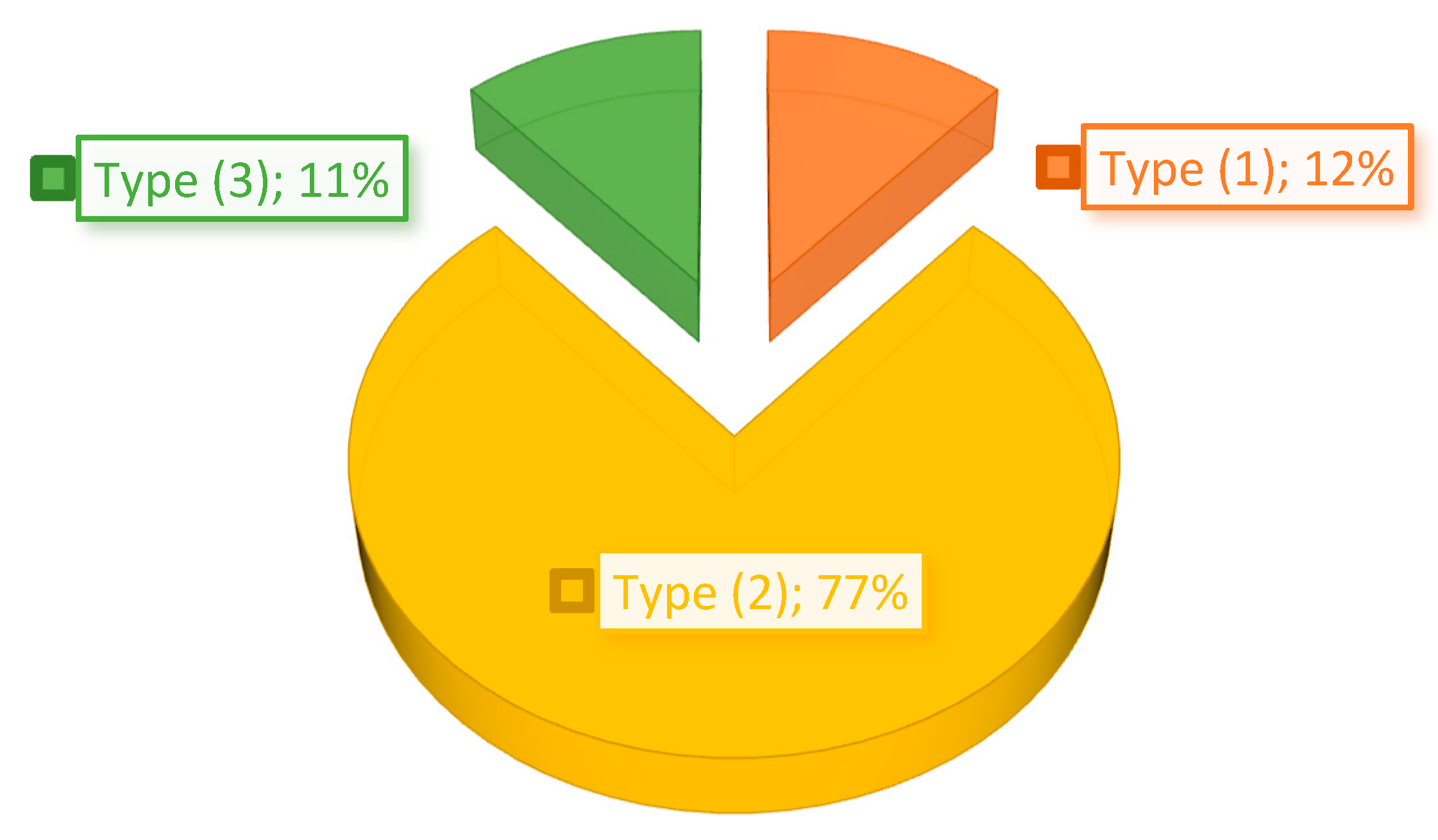


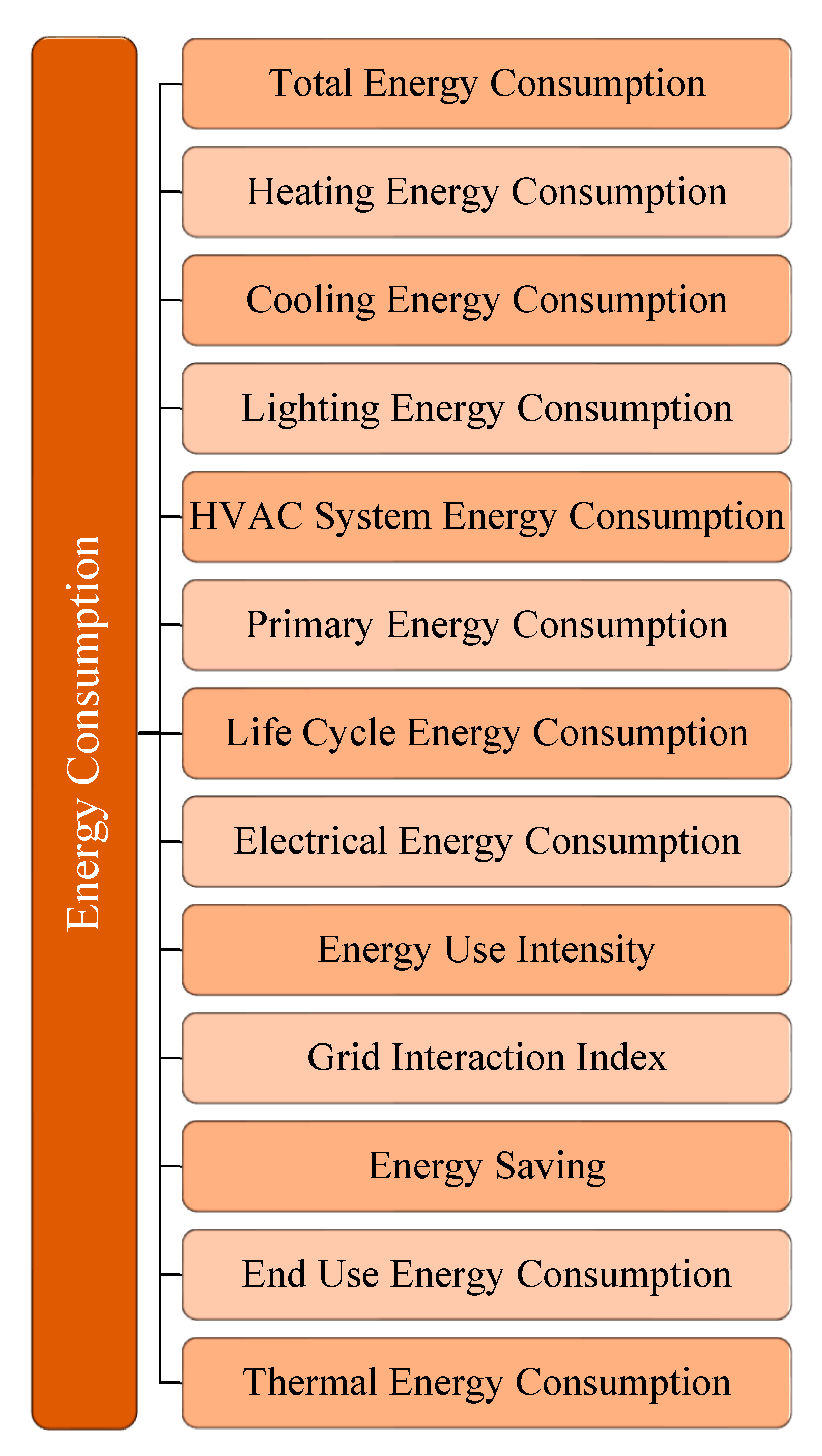
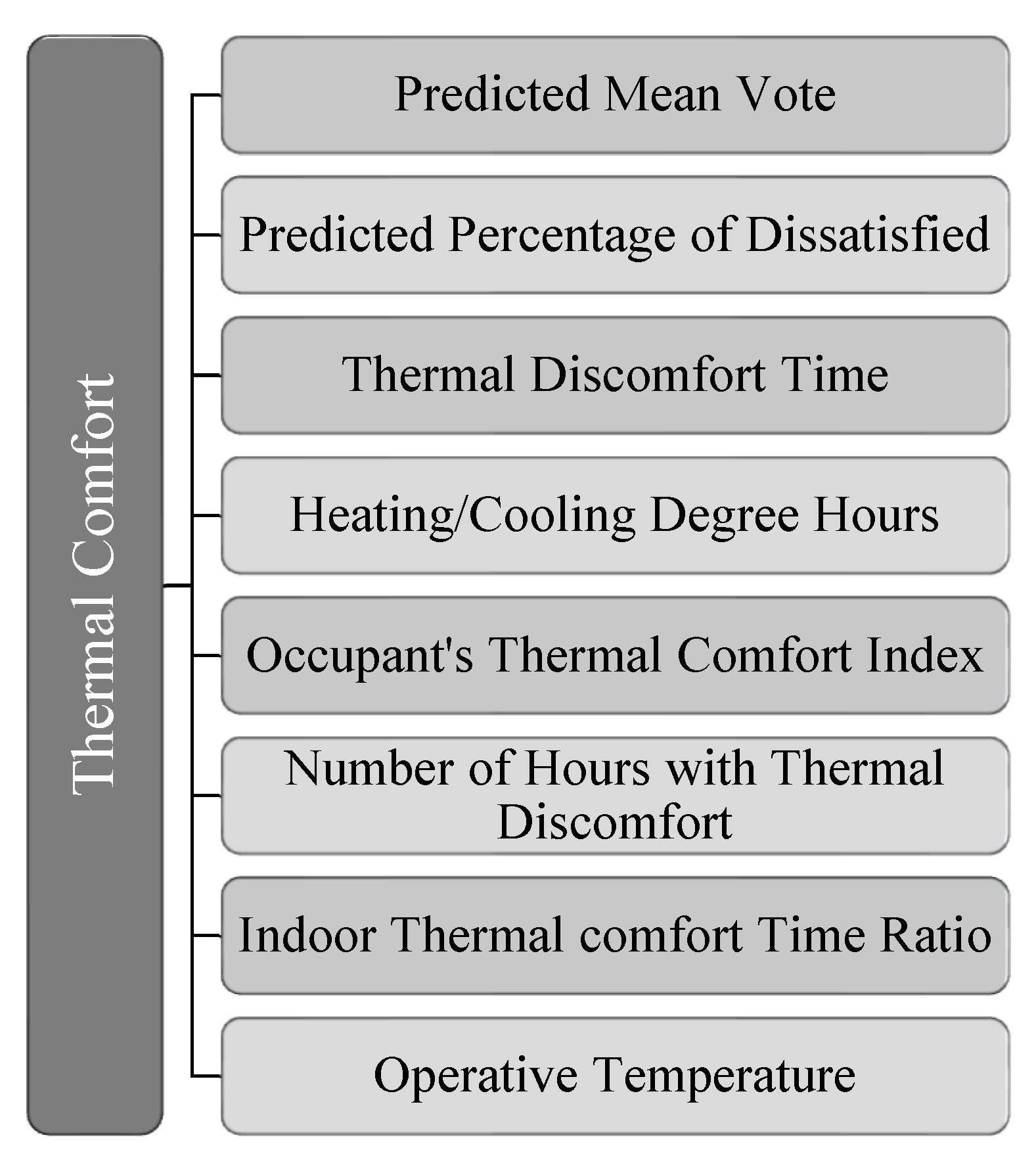
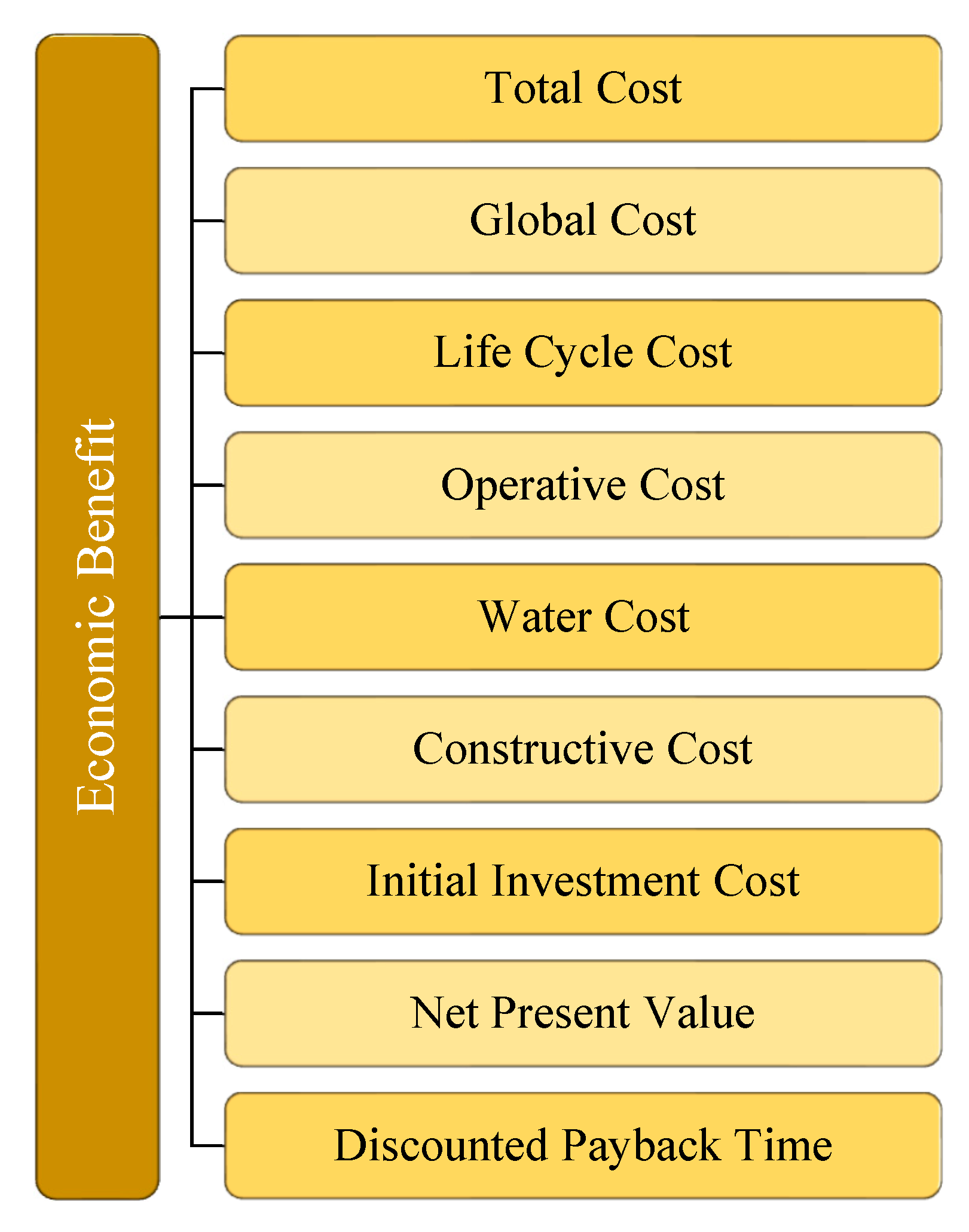
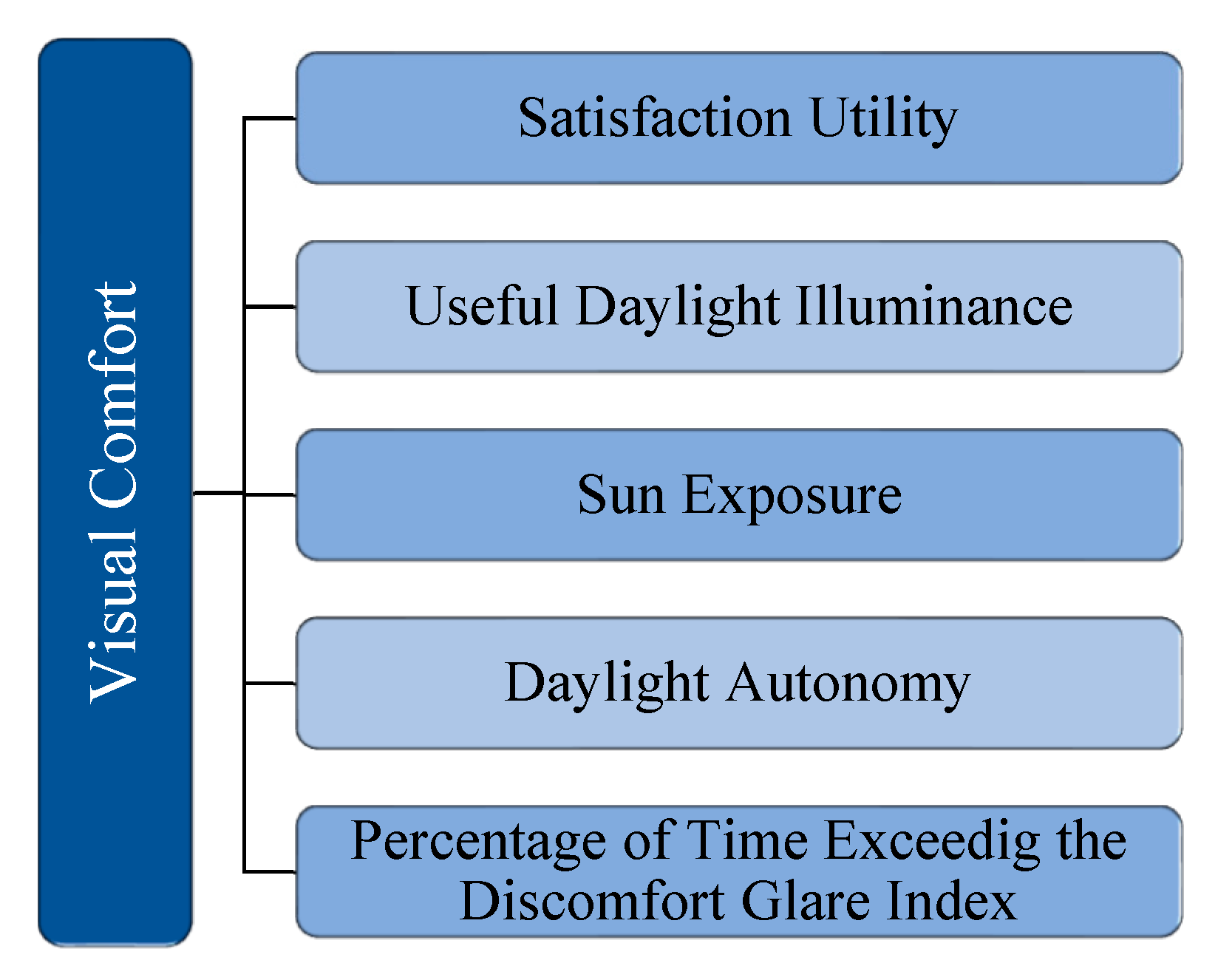

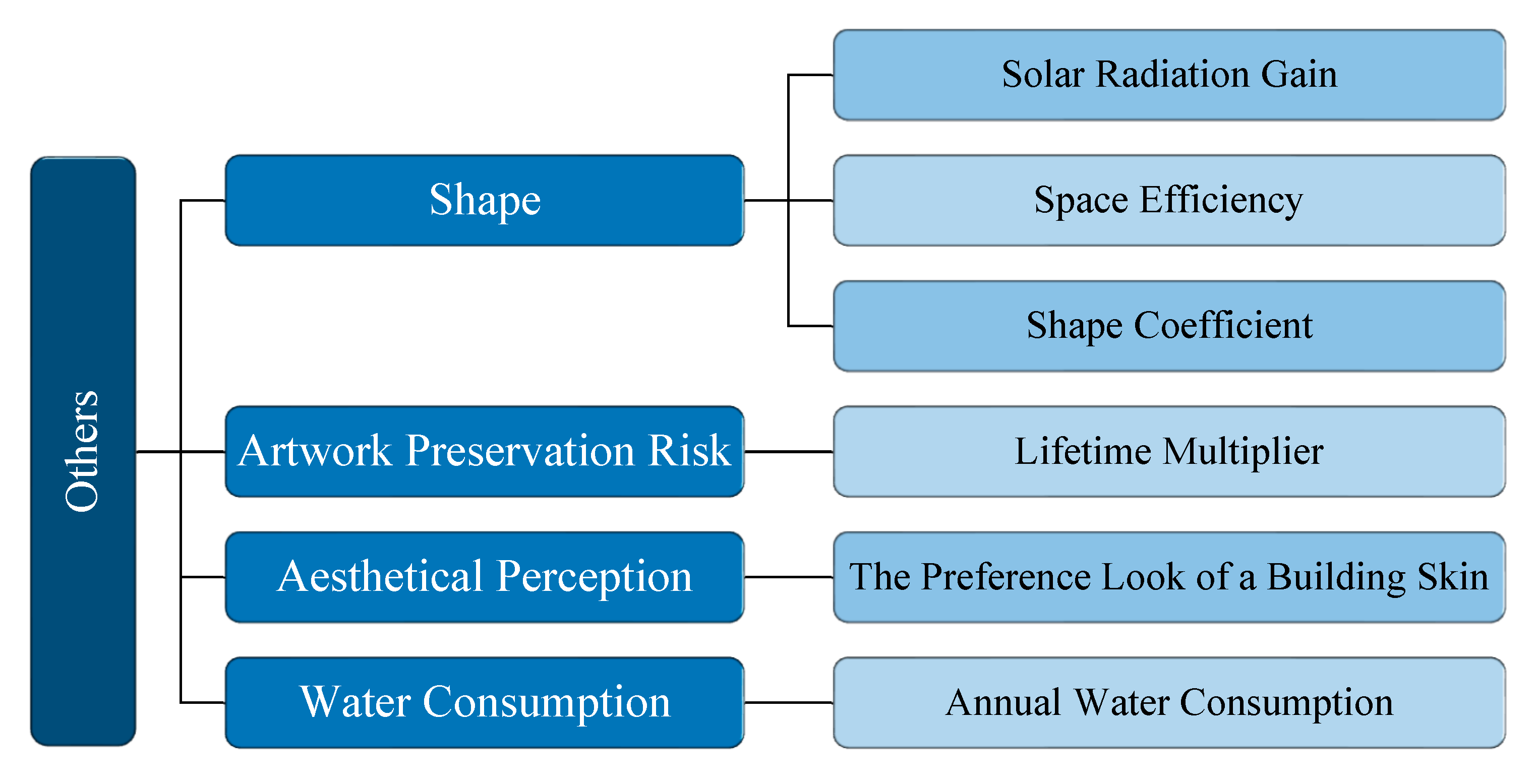
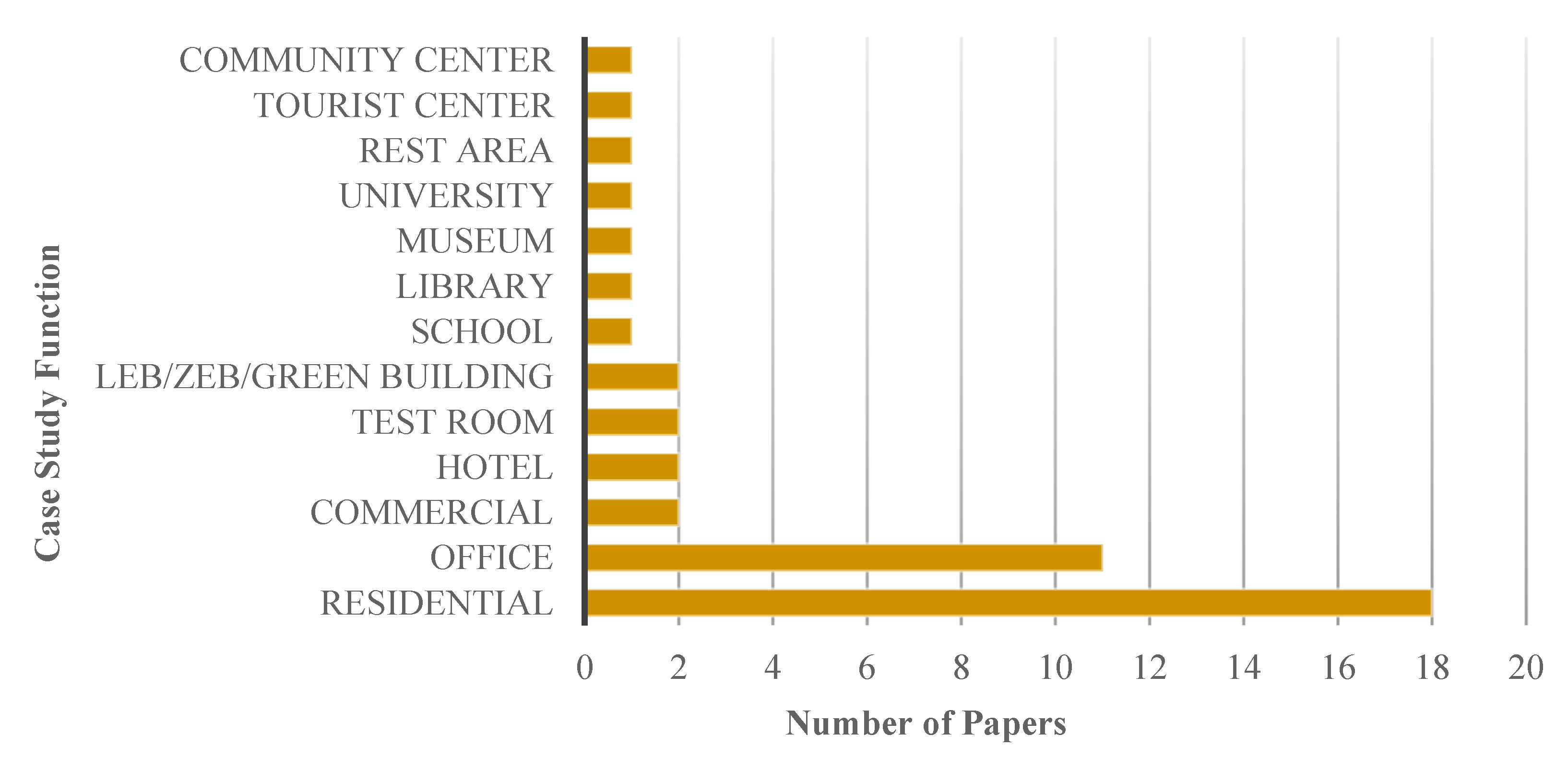
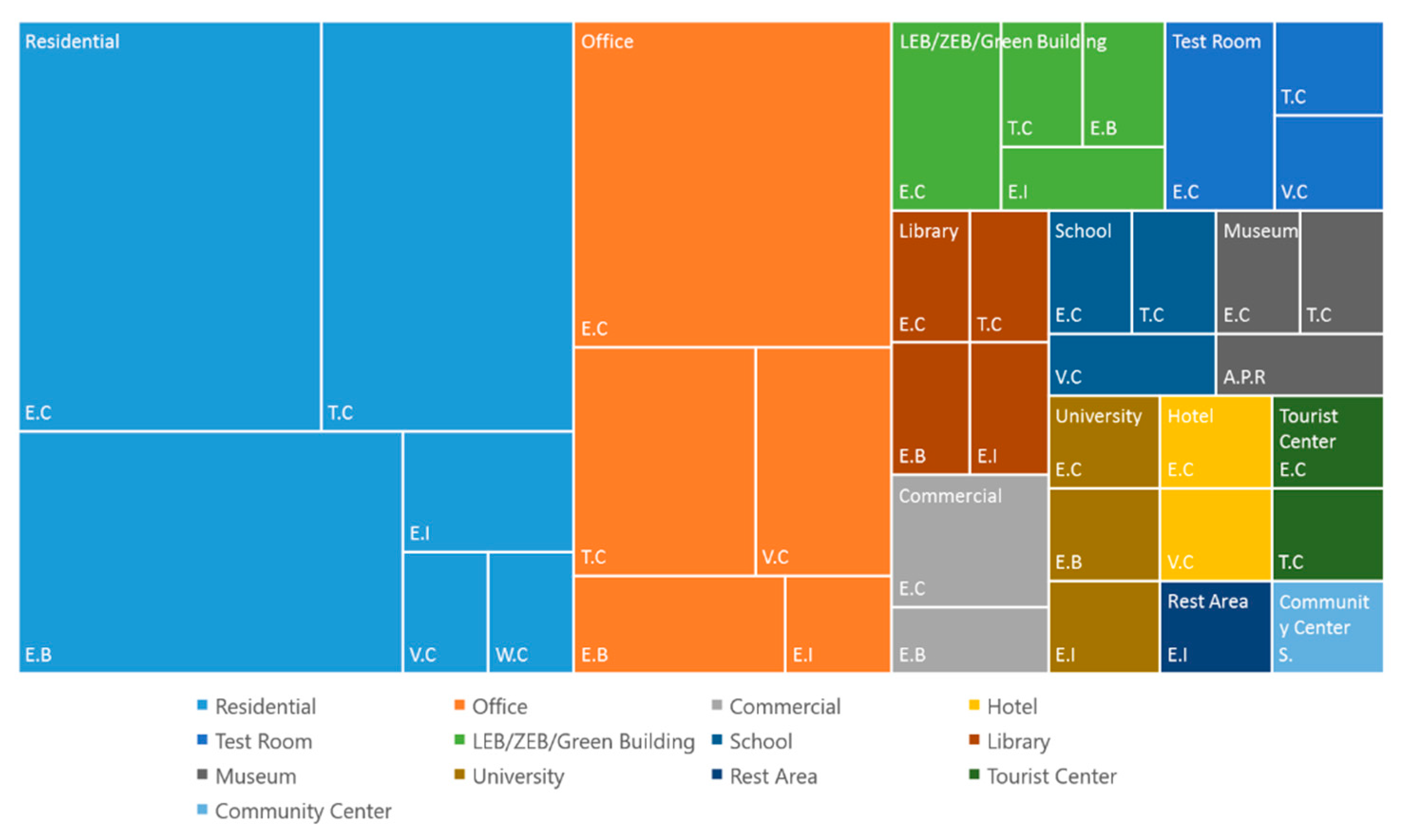
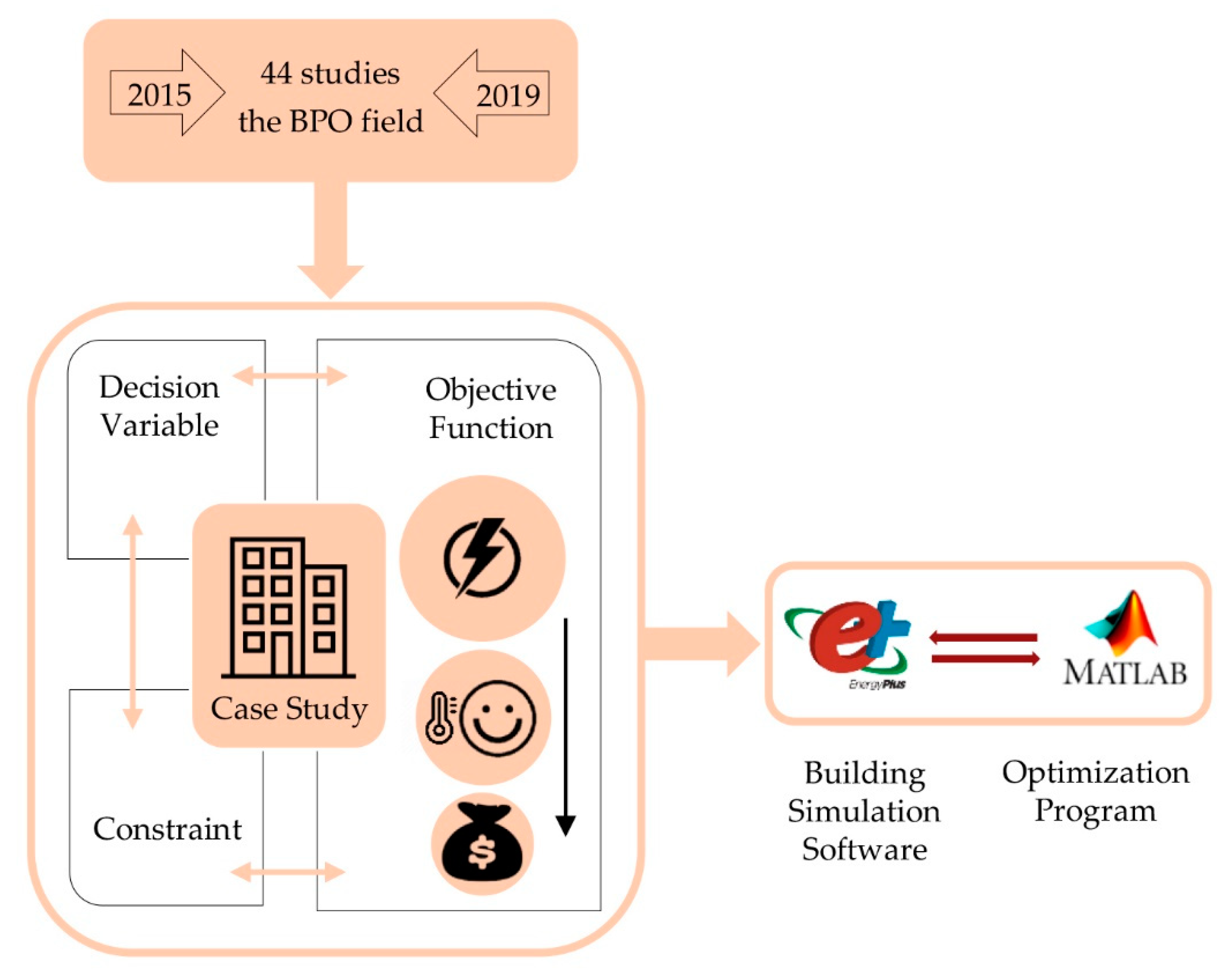
| Study | Year | The Main Drawbacks |
|---|---|---|
| Wong and Zhou [18] | 2015 |
|
| Carlucci et al. [19] | 2015 |
|
| Shi et al. [20] | 2016 |
|
| Bonyadi and Michalewicz [21] | 2017 |
|
| Kumar et al. [22] | 2017 |
|
| Tian et al. [23] | 2018 |
|
| Ekici et al. [24] | 2019 |
|
| Alothaimeen and Arditi [25] | 2019 |
|
| Joench et al. [26] | 2019 |
|
| Study | Year | Optimization Approach | |
|---|---|---|---|
| SOO | MOO | ||
| Abdallah and El-Rayes [27] | 2015 | √ | |
| Mangkuto et al. [28] | 2016 | √ | |
| Ferdyn-Grygierek and Grygierek [29] | 2017 | √ | |
| Baglivo et al. [30] | 2017 | √ | |
| Bamdad et al. [31] | 2017 | √ | |
| Zhou et al. [32] | 2018 | √ | |
| Li et al. [33] | 2018 | √ | |
| Sghiouri et al. [34] | 2018 | √ | |
| Xue et al. [35] | 2019 | √ | |
| Echenagucia et al. [36] | 2015 | √ | |
| Yu et al. [37] | 2015 | √ | |
| Carlucci et al. [38] | 2015 | √ | |
| Ascione et al. [39] | 2015 | √ | |
| Zhang et al. [40] | 2016 | √ | |
| Gadelhak and Lang [41] | 2016 | √ | |
| Pan et al. [42] | 2016 | √ | |
| Ascione et al. [43] | 2017 | √ | |
| Bingham et al. [44] | 2017 | √ | |
| Zhang et al. [45] | 2017 | √ | |
| Mostavi et al. [46] | 2017 | √ | |
| Bre and Fachinotti [47] | 2017 | √ | |
| Hamdy and Mauro [48] | 2017 | √ | |
| Wu et al. [49] | 2018 | √ | |
| Lin et al. [50] | 2018 | √ | |
| Grygierek and Ferdyn-Grygierek [51] | 2018 | √ | |
| Schito et al. [52] | 2018 | √ | |
| Gou et al. [53] | 2018 | √ | |
| Harkouss et al. [54] | 2018 | √ | |
| Sohani et al. [55] | 2019 | √ | |
| Zemero et al. [56] | 2019 | √ | |
| Yi [57] | 2019 | √ | |
| Hong et al. [58] | 2019 | √ | |
| Kirimtat et al. [59] | 2019 | √ | |
| Ascione et al. [60] | 2019 | √ | |
| Zhai et al. [61] | 2019 | √ | |
| Si et al. [62] | 2019 | √ | |
| Sharif and Hammad [63] | 2019 | √ | |
| Fang and Cho [64] | 2019 | √ | |
| Sohani et al. [65] | 2019 | √ | |
| Lu et al. [66] | 2015 | √ | √ |
| Delgarm et al. [67] | 2016 | √ | √ |
| Delgarm et al. [68] | 2016 | √ | √ |
| Delgarm et al. [69] | 2016 | √ | √ |
| Xiong et al. [70] | 2019 | √ | √ |
| Study | Considered Aspect | Objective Function | ||||||||
|---|---|---|---|---|---|---|---|---|---|---|
| E.C | T.C | E.B | V.C | E.I | S. | A.P.R | A.P | W.C | ||
| Abdallah and El-Rayes [27] | ✓ | ✓ | Min. Building Environmental Impacts Index | |||||||
| Mangkuto et al. [28] | ✓ | Min. Total Annual Lighting Energy Demand | ||||||||
| Ferdyn-Grygierek and Grygierek [29] | ✓ | Min. Life-Cycle Cost | ||||||||
| Baglivo et al. [30] | ✓ | Opt. The Operative Temperature | ||||||||
| Bamdad et al. [31] | ✓ | Min. Annual End Use Energy Consumption | ||||||||
| Zhou et al. [32] | ✓ | Min. Annual Heating Energy Consumption | ||||||||
| Li et al. [33] | ✓ | Min. Total Energy Consumption (Heating + Cooling + Lighting) | ||||||||
| Sghiouri et al. [34] | ✓ | Min. Discomfort Degree-hours | ||||||||
| Xue et al. [35] | ✓ | Min. Annual Cooling Load | ||||||||
| Echenagucia et al. [36] | ✓ |
| ||||||||
| Yu et al. [37] | ✓ | ✓ |
| |||||||
| Carlucci et al. [38] | ✓ | ✓ |
| |||||||
| Ascione et al. [39] | ✓ | ✓ |
| |||||||
| Zhang et al. [40] | ✓ |
| ||||||||
| Gadelhak and Lang [41] | ✓ | ✓ | ✓ |
| ||||||
| Pan et al. [42] | ✓ | ✓ |
| |||||||
| Ascione et al. [43] | ✓ | ✓ |
| |||||||
| Bingham et al. [44] | ✓ | ✓ |
| |||||||
| Zhang et al. [45] | ✓ | ✓ | ✓ |
| ||||||
| Mostavi et al. [46] | ✓ | ✓ | ✓ |
| ||||||
| Bre and Fachinotti [47] | ✓ | ✓ |
| |||||||
| Hamdy and Mauro [48] | ✓ | ✓ |
| |||||||
| Wu et al. [49] | ✓ | ✓ |
| |||||||
| Lin et al. [50] | ✓ | ✓ |
| |||||||
| Grygierek and Ferdyn-Grygierek [51] | ✓ | ✓ |
| |||||||
| Schito et al. [52] | ✓ | ✓ |
| |||||||
| Gou et al. [53] | ✓ | ✓ |
| |||||||
| Harkouss et al. [54] | ✓ | ✓ |
| |||||||
| Sohani et al. [55] | ✓ | ✓ |
| |||||||
| Zemero et al. [56] | ✓ | ✓ |
| |||||||
| Yi [57] | ✓ | ✓ |
| |||||||
| Hong et al. [58] | ✓ | ✓ | ✓ | ✓ |
| |||||
| Kirimtat et al. [59] | ✓ | ✓ |
| |||||||
| Ascione et al. [60] | ✓ | ✓ | ✓ |
| ||||||
| Zhai et al. [61] | ✓ | ✓ | ✓ |
| ||||||
| Si et al. [62] | ✓ | ✓ |
| |||||||
| Sharif and Hammad [63] | ✓ | ✓ | ✓ |
| ||||||
| Fang and Cho [64] | ✓ | ✓ |
| |||||||
| Sohani et al. [65] | ✓ | ✓ | ✓ | ✓ |
| |||||
| Lu et al. [66] | ✓ | ✓ | ✓ |
| ||||||
| Delgarm et al. [67] | ✓ |
| ||||||||
| Delgarm et al. [68] | ✓ | ✓ |
| |||||||
| Delgarm et al. [69] | ✓ |
| ||||||||
| Xiong et al. [70] | ✓ | ✓ |
| |||||||
| Study | Decision Variables |
|---|---|
| Abdallah and El-Rayes [27] |
|
| Mangkuto et al. [28] |
|
| Ferdyn-Grygierek and Grygierek [29] |
|
| Baglivo et al. [30] |
|
| Bamdad et al. [31] |
|
| Zhou et al. [32] |
|
| Li et al. [33] |
|
| Sghiouri et al. [34] |
|
| Xue et al. [35] |
|
| Echenagucia et al. [36] |
|
| Yu et al. [37] |
|
| Carlucci et al. [38] |
|
| Ascione et al. [39] |
|
| Zhang et al. [40] |
|
| Gadelhak and Lang [41] |
|
| Pan et al. [42] |
|
| Ascione et al. [43] |
|
| Bingham et al. [44] |
|
| Zhang et al. [45] |
|
| Mostavi et al. [46] |
|
| Bre and Fachinotti [47] |
|
| Hamdy and Mauro [48] |
|
| Wu et al. [49] |
|
| Lin et al. [50] |
|
| Grygierek and Ferdyn-Grygierek [51] |
|
| Schito et al. [52] |
|
| Gou et al. [53] |
|
| Harkouss et al. [54] |
|
| Sohani et al. [55] |
|
| Zemero et al. [56] |
|
| Yi [57] |
|
| Hong et al. [58] |
|
| Kirimtat et al. [59] |
|
| Ascione et al. [60] |
|
| Zhai et al. [61] |
|
| Si et al. [62] |
|
| Sharif and Hammad [63] |
|
| Fang and Cho [64] |
|
| Sohani et al. [65] |
|
| Lu et al. [66] |
|
| Delgarm et al. [67] |
|
| Delgarm et al. [68] |
|
| Delgarm et al. [69] |
|
| Xiong et al. [70] |
|
| Study | Constraints |
|---|---|
| Abdallah and El-Rayes [27] |
|
| Mangkuto et al. [28] |
|
| Ferdyn-Grygierek and Grygierek [29] |
|
| Baglivo et al. [30] |
|
| Bamdad et al. [31] |
|
| Zhou et al. [32] |
|
| Li et al. [33] |
|
| Sghiouri et al. [34] |
|
| Xue et al. [35] |
|
| Echenagucia et al. [36] |
|
| Yu et al. [37] |
|
| Carlucci et al. [38] |
|
| Ascione et al. [39] |
|
| Zhang et al. [40] |
|
| Gadelhak and Lang [41] |
|
| Pan et al. [42] |
|
| Ascione et al. [43] |
|
| Bingham et al. [44] |
|
| Zhang et al. [45] |
|
| Mostavi et al. [46] |
|
| Bre and Fachinotti [47] |
|
| Hamdy and Mauro [48] |
|
| Wu et al. [49] |
|
| Lin et al. [50] |
|
| Grygierek and Ferdyn-Grygierek [51] |
|
| Schito et al. [52] |
|
| Gou et al. [53] |
|
| Harkouss et al. [54] |
|
| Sohani et al. [86] |
|
| Zemero et al. [56] |
|
| Yi [57] |
|
| Hong et al. [58] |
|
| Kirimtat et al. [59] |
|
| Ascione et al. [60] |
|
| Zhai et al. [61] |
|
| Si et al. [62] |
|
| Sharif and Hammad [63] |
|
| Fang and Cho [64] |
|
| Sohani et al. [65] |
|
| Lu et al. [66] |
|
| Delgarm et al. [67] |
|
| Delgarm et al. [68] |
|
| Delgarm et al. [69] |
|
| Xiong et al. [70] |
|
| Study | Building Function | Location |
|---|---|---|
| Abdallah and El-Rayes [27] | Rest Area | N.M. |
| Mangkuto et al. [28] | Office | Bandung in Indonesia |
| Ferdyn-Grygierek and Grygierek [29] | Residential | Katowice in Poland |
| Baglivo et al. [30] | Residential | Southern Italy |
| Bamdad et al. [31] | Commercial | Brisbane, Darwin, Hobart and Melbourne, in Australia |
| Zhou et al. [32] | Residential | Tianjin in China |
| Li et al. [33] | Office | Beijing, Shanghai and Guangzhou, in China |
| Sghiouri et al. [34] | Residential | Marrakech, Casablanca and Oujda, in Morocco |
| Xue et al. [35] | Hotel | Shanghai, Qionghai and Fuzhou, in China |
| Echenagucia et al. [36] | Office | Palermo, Torino, Frankfurt and Oslo |
| Yu et al. [37] | Residential | Chongqing in China |
| Carlucci et al. [38] | Residential | Mascalucia (CT) in Southern Italy |
| Ascione et al. [39] | Residential | Naples in Italy and Istanbul in Turkey |
| Zhang et al. [40] | Community Center | Shenyang in China |
| Gadelhak and Lang [41] | Office | Cairo in Egypt and Munich in Germany |
| Pan et al. [42] | Residential | Nanjing in China |
| Ascione et al. [43] | Office | Naples in South Italy |
| Bingham et al. [44] | Residential | Bahamas |
| Zhang et al. [45] | School | Tianjin in China |
| Mostavi et al. [46] | Office | Pennsylvania in The USA |
| Bre and Fachinotti [47] | Residential | Paraná in Argentine |
| Hamdy and Mauro [48] | Residential | Helsinki in Finland |
| Wu et al. [49] | Residential | Tianjin in China |
| Lin et al. [50] | A two-star green building | Wuhan in China. |
| Grygierek and Ferdyn-Grygierek [51] | Residential | Poland |
| Schito et al. [52] | Museum | Pisa in Italy |
| Gou et al. [53] | Residential | Shanghai in China |
| Harkouss et al. [54] | Residential | Beirut, Qartaba, Zahle and Cedars in Lebanon, Embrun, La Rochelle, Nice, Nancy and Limoges in France |
| Sohani et al. [86] | Residential | Riyadh in Saudi Arabia, Ahmedabad in India, Windsor in Canada, London in the UK |
| Zemero et al. [56] | Commercial | Curitiba, Florianópolis, Campo Grande and Belém in Brazil |
| Yi [57] | Hotel | Barcelona in Spain |
| Hong et al. [58] | Library | Seoul in South Korea |
| Kirimtat et al. [59] | Office | Izmir in Turkey |
| Ascione et al. [60] | Residential | Palermo, Naples, Milan and Florence, In Italy |
| Zhai et al. [61] | Test room | Xi’an in China |
| Si et al. [62] | Tourist center | Nanjing in China |
| Sharif and Hammad [63] | University | Montreal in Canada |
| Fang and Cho [64] | Office | Miami, Atlanta, Chicago in the USA |
| Sohani et al. [65] | Residential | Riyadh in Saudi Arabia, Ahmedabad in India, Windsor in Canada, London in the UK |
| Lu et al. [66] | Two types of buildings (LEB and ZEB) | Hong Kong in China |
| Delgarm et al. [67] | A single thermal zone test case room. | Tabriz, Tehran, Kerman and Bandar Abbas, in Iran |
| Delgarm et al. [68] | Office | Tabriz, Tehran, Kerman and Bandar Abbas, in Iran |
| Delgarm et al. [69] | Office | Tabriz, Tehran, Kerman and Bandar Abbas, in Iran |
| Xiong et al. [70] | Office | West Lafayette in Indiana |
| Study | Optimization Algorithm | Software | |
|---|---|---|---|
| Simulation | Optimization | ||
| Abdallah and El-Rayes [27] | Genetic Algorithm | eQUEST | N.M. |
| Mangkuto et al. [28] | Graphical Optimisation Method | Radiance, Daysim | N.M. |
| Ferdyn-Grygierek and Grygierek [29] | Genetic Algorithm | EnergyPlus | MATLAB |
| Baglivo et al. [30] | Sequential Search Technique | TRNSYS | TRNSYS |
| Bamdad et al. [31] | Ant Colony Optimisation for continuous domain | EnergyPlus | GenOpt, MATALB |
| Zhou et al. [32] | Measurement | N.A. | N.A. |
| Li et al. [33] | Genetic Algorithm | DesignBuilder, Radiance | MATLAB |
| Sghiouri et al. [34] | NSGA-II | TRNSYS | jEPlus + EA |
| Xue et al. [35] | N.M. | Radiance, EnergyPlus | N.M. |
| Echenagucia et al. [36] | NSGA-II | EnergyPlus | Python |
| Yu et al. [37] | NSGA-II | EnergyPlus | MATLAB |
| Carlucci et al. [38] | NSGA-II | EnergyPlus | GenOpt, Java Genetic Algorithms Package |
| Ascione et al. [39] | NSGA-II | EnergyPlus | MATLAB |
| Zhang et al. [40] | Multi-objective Genetic Algorithm | Rhinoceros and its plug-ins Grasshopper, Ladybug, | Octopus |
| Gadelhak and Lang [41] | Multi-Objective SPEA-2 Optimization Algorithm | Rhinoceros’s plug-ins Diva, Grasshopper, Ladybug and Honeybee | Octopus |
| Pan et al. [42] | NSGA-II | EnergyPlus | MATLAB |
| Ascione et al. [43] | Multi-objective Genetic Algorithm | EnergyPlus | MATLAB |
| Bingham et al. [44] | NSGA-II | EnergyPlus | jEPlus + EA |
| Zhang et al. [45] | Multi-Objective SPEA-2 Optimization Algorithm | Rhinoceros and its plug-ins Grasshopper, Ladybug, Honeybee | Octopus |
| Mostavi et al. [46] | A Harmony Search Based Algorithm | EnergyPlus | C# |
| Bre and Fachinotti [47] | NSGA-II | EnergyPlus | Python |
| Hamdy and Mauro [48] | The optimization algorithm PR_GA_RF | IDA ICE | MATLAB |
| Wu et al. [49] | NSGA-II | DesignBuilder | MATLAB |
| Lin et al. [50] | Multi-objective Genetic Algorithm | DesignBuilder | MATLAB |
| Grygierek and Ferdyn-Grygierek [51] | NSGA-II | EnergyPlus | MATLAB |
| Schito et al. [52] | N.M. | TRNSYS | MATLAB |
| Gou et al. [53] | NSGA-II coupled with the Artificial Neural Network | EnergyPlus | MATLAB, jE-Plus |
| Harkouss et al. [54] | NSGA-II | TRNSYS | MOBO |
| Sohani et al. [86] | NSGA-II | Carrier Hourly Analysis Program | MATLAB |
| Zemero et al. [56] | PAES multi-objective optimization algorithm | EnergyPlus | Python |
| Yi [57] | NSGA-II | Rhinoceros and its plug-ins DIVA, Grasshopper and Human UI | MATLAB |
| Hong et al. [58] | NSGA-II | EnergyPlus | Python |
| Kirimtat et al. [59] | Non-dominated Sorting Genetic Algorithm and Self-adaptive Continuous Genetic Algorithm with Differential Evolution | Radiance, EnergyPlus | N.M. |
| Ascione et al. [60] | NSGA-II | EnergyPlus | MATLAB |
| Zhai et al. [61] | NSGA-II | EnergyPlus | MATLAB |
| Si et al. [62] | NSGA-II | EnergyPlus | MATLAB, modeFrontier |
| Sharif and Hammad [63] | NSGA-II | DesignBuilder | ATHENA |
| Fang and Cho [64] | Multi-objective Genetic Algorithm | Rhinoceros and its plug-ins Grasshopper, Ladybug, Honeybee | Octopus |
| Sohani et al. [65] | NSGA-II | Carrier Hourly Analysis Program | MATLAB |
| Lu et al. [66] | NSGA-II | TRNSYS | MATLAB |
| Delgarm et al. [67] | Multi-Objective Particle Swarm Optimization Algorithm | EnergyPlus | MATLAB |
| Delgarm et al. [68] | Multi-Objective Artificial Bee Colony Optimization Algorithm | EnergyPlus | MATLAB |
| Delgarm et al. [69] | NSGA-II | EnergyPlus | MATLAB, jE-Plus |
| Xiong et al. [70] | N.M. | N.M. | MATLAB |
Publisher’s Note: MDPI stays neutral with regard to jurisdictional claims in published maps and institutional affiliations. |
© 2021 by the authors. Licensee MDPI, Basel, Switzerland. This article is an open access article distributed under the terms and conditions of the Creative Commons Attribution (CC BY) license (http://creativecommons.org/licenses/by/4.0/).
Share and Cite
Mousavi Motlagh, S.F.; Sohani, A.; Djavad Saghafi, M.; Sayyaadi, H.; Nastasi, B. The Road to Developing Economically Feasible Plans for Green, Comfortable and Energy Efficient Buildings. Energies 2021, 14, 636. https://doi.org/10.3390/en14030636
Mousavi Motlagh SF, Sohani A, Djavad Saghafi M, Sayyaadi H, Nastasi B. The Road to Developing Economically Feasible Plans for Green, Comfortable and Energy Efficient Buildings. Energies. 2021; 14(3):636. https://doi.org/10.3390/en14030636
Chicago/Turabian StyleMousavi Motlagh, Seyedeh Farzaneh, Ali Sohani, Mohammad Djavad Saghafi, Hoseyn Sayyaadi, and Benedetto Nastasi. 2021. "The Road to Developing Economically Feasible Plans for Green, Comfortable and Energy Efficient Buildings" Energies 14, no. 3: 636. https://doi.org/10.3390/en14030636
APA StyleMousavi Motlagh, S. F., Sohani, A., Djavad Saghafi, M., Sayyaadi, H., & Nastasi, B. (2021). The Road to Developing Economically Feasible Plans for Green, Comfortable and Energy Efficient Buildings. Energies, 14(3), 636. https://doi.org/10.3390/en14030636










